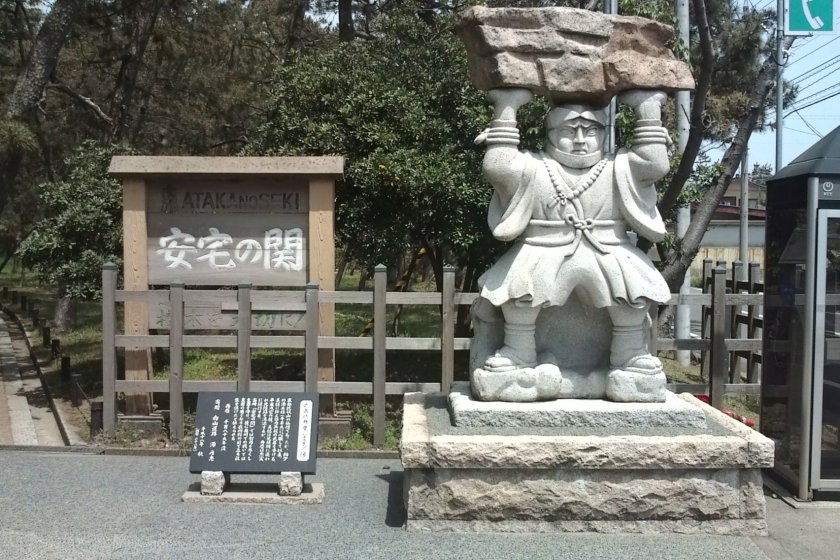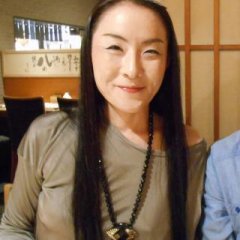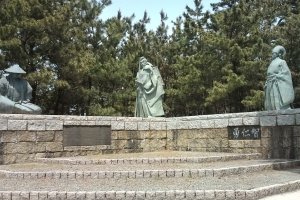If you are a big fan of Kabuki, or even if you are not, if you have ever seen any TV dramas or movies about Minamoto no Yoshitsune (1159-1189), the name 'Ataka-no-Seki' (Ataka Checkpoint or Ataka Barrier Ruins) might ring a bell. This place is the locale of the well-known Kabuki play, 'Kanjincho'.
For those who don't know anything about Yoshitsune, here's a brief overview of his life. Minamoto no Yoshitsune is a half brother of Minamoto no Yoritomo, who was the founder of the Kamakura Shogunate. Yoritomo was the son of his father's official wife, while on the other hand Yoshitsune was the son of a concubine mother. When their father, the heir of the Minamoto clan, was defeated by the Taira clan in the Heiji Rebellion, Yoritomo was exiled to Izu (in Shizuoka prefecture), and Yoshitsune was put under the care of the Kurama Temple, which is located in the mountains north-west of the city of Kyoto.
Later, when Yoritomo rose up in arms in East Japan, Yoshitsune rallied round the flag to help his half brother establish the world of samurai for the first time in Japan's history. Yoshitsune worked very hard to help his big brother, and since he was gifted in war tactics he won important battles one after another, waving his baton and sword. Finally, he defeated the Taira clan in the Battle of Dan-no-ura, and destroyed them entirely. After the glorious victory he came back to Kyoto, where he received a special title from the Emperor without his brother Yoritomo's consent. Yoritomo felt threatened by Yoshitsune's success in the Emperor's court. Yoritomo's subordinates were also jealous of Yoshitsune. Yoshitsune became involved in devious conspiracies and power games involving the Imperial court, and ended up being pursued and expelled by Yoritomo. He fled from Kyoto and tried to reach Ohshu (North-east Japan), and on the way it is said that he passed through this 'Ataka-no-Seki', Checkpoint.
I love Kabuki and history in general. But I'm not as fanaticaly enthusiastic about them as some history-loving women (so-called rekijo) who wouldn't hesitate climbing mountains and crossing fields in bad weather just to get to a place related to a historical figure or Kabuki play. Therefore, it was no wonder I didn't know 'Ataka-no-Seki' was in my neighborhood. However, one day when I was at Komatsu Airport, the main airport for three prefectures in the Hokuriku region, I bumped into dolls of Yoshitsune, Benkei and Togashi, the three main roles of the famous Kabuki play 'Kanjincho', and wondered, "Why in the world are there dolls of Kanjincho in a place like this?" I asked around and found that 'Ataka-no-Seki', the locale of Kanjincho is only a 5-10 minute drive from Komatsu Airport! I wouldn't be able to tell the world, 'I'm a fan of Kabuki & history' if I didn't visit the place. Well, I was trapped.
So, I dropped by the place on the way back home. They had told me the truth; it took me less than 10 minutes to reach it. The entire place faces the Japan Sea, and there is a stone monument which reads 'Ataka Checkpoint Ruins' in a pinewood grove. After you get through the woods you see the statues of Yoshitsune, Benkei and Togashi standing on the beach. Nearby, there is the Kanjincho Story Museum, inside of which the Kabuki costumes actually worn by the late Ichikawa Danjuro are displayed. Bunraku Dolls of Kanjincho are also displayed. For your information, the model of Benkei's statue on the beach was Matsumoto Koshiro VII (grandfather of Koshiro IX). And Ichikawa Sadanji II was the model of Togashi's statue. Then who was the model of Yoshitsune's statue?
There was not much else to see, as in many other ruins in Japan. But once I stepped into the pines, I closed my eyes and felt the soft wind from the sea on my cheek, and somehow was filled with the sense of solemnity and wonder: I was in the early 12 century when Yoshitsune lived and died a violent death. I wondered if he actually fled through this barren woods fighting with the wild sea wind blustering at him from the roaring Japan Sea. I saw Yoshitsune and Benkei in my eyes, fighting the sea wind in shabby clothes.
After enjoying my own wild imagination, I went to the Kanjincho Story Museum. Inside was all about 'Kanjincho'. When I saw the Kabuki costume actually worn by Danjuro, all the solemn sympathy for Yoshitsune and Benkei just evaporated from my mind and I got excited like a child. Here, you can also see videos of the Kabuki play, and get to know Japanese traditional performing arts deeply.
The museum is open from 9am to 5pm everyday except for Wednesdays and around New Years Day. The entrance fee is 300 yen/adults, 150 yen/younger than high-school students.
You can enter 'Ataka-no-Seki' for free, so if you are into Yoshitsune or Kanjincho, you can spend the whole day in the pinewoods if you want. Like most tourist spots in Fukui or Hokuriku, there are not many people. So it's possible to monoplize 'Ataka-no-Seki'' all to yourself, the holy place for Yoshitsune fans. However, I'd recommend you bundle up in winter. Unless you were as desperate as Yoshitsune and Benkei and felt as numb as they did, the winter wind from Japan Sea will be deathly cold.
If you ever come to the Hokuriku region via Komatsu Airport, just drop by this historical sight 'Ataka-no-Seki'.



































